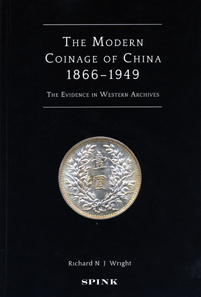by Ursula Kampmann
June 6, 2013 – Scholarly literature on Chinese minting, easily accessible in a Western language? That is hard to find. Thus, when looking for background knowledge particularly about the early coins China had produced between 1866 and 1949, which are much sought-after and traded at high prices, one has to rely on scattered information. The latest book by Richard N. J. Wright now provides a deep insight into China’s monetarization Western-style.
Richard N. J. Wright, The Modern Coinage of China 1866-1949. The Evidence in Western Archives. Edited by Joe Cribb and Helen Wang. Spink, London 2012. 308p. b/w images. Hardcover, 27.1 x 18cm. ISBN: 978-1-907427-20-6. 45 GBP.
All the chapters on different aspects of Chinese minting had already been published as individual papers in several publications. Whereas those who had made their way into the Numismatic Chronicle or Numismatic Circular were rather easy to come by, these valuable contributions to numismatics are also hidden in places that are much more difficult to find. It is thanks to the editors Joe Cribb and Helen Wang, both being responsible for the Far Eastern coins in the British Museum, that the individual papers were standardized to the effect that the wealth of information now provides a marvelous picture of Chinese coin production.
Author Richard Wright has its own connection with China. He visited this fascinating country for the first time when he was at the tender of just a few months. Since then, he wanted to know everything about China. Being a member of the navy, he was happy to be stationed in the Far East regularly. It was in Hong Kong, in 1960, that he bought his first Chinese silver dollar. Once he engaged himself with this one and other coins, however, he realized that information were scarce on numerous pieces. It was a matter of dispute when they had been minted and, most of all, where (there had been countless small mints in the provinces) – in addition, in the turmoil of the great number of wars many archives were destroyed so that it is rather difficult to find out how many piece had been produced. And there were later collectors’ editions and counterfeits that further clouded the picture. Richard Wright started to deal with these questions on a scientific level and published his first paper on Republican mints in Honan in 1974.
In the previous 40 or so years he published 38 articles. They are all drawn together here, in the order of their date of publication. Hence, the reader of this book is faced with a mass of information which, admittedly, is a bit troublesome to access. Especially those readers who don’t already know a thing or two about the history of Chinese minting (and this little book review’s author counts herself among these) have to spend some time turning pages in order to find out if there is any information available on the coin they are interested in. But very often you will make a find – and instantly will be faced with the complex questions that accompany these coins. For example, there is not ‘a’ Yuan Shi Kai Dollar but 21 different die variants, of which a number were minted under the official date ‘3rd Year’ between 1915 and the 1950e in different mints. Or take the popular coins with the dragon as motif. Did you know that they were produced in roughly 14 mints between 1887/8 and 1949?
Thus, there is a lot to learn in this book. And perhaps it makes you understand better the next time why a certain variant of a Chinese coin obtains a better result in an auction than another one does. As was said above, although this book is not a catalog, it is a must-have for anyone dealing with modern Chinese money.
You can order this book at Spink, London.





